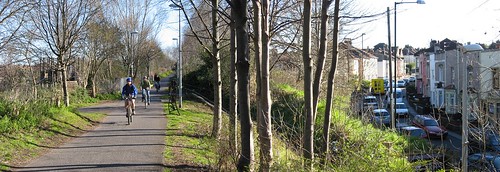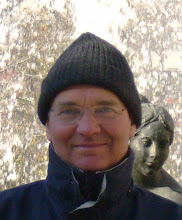
Just 26 years after I started campaigning in earnest for cycling to be taken seriously as a form of transport, and just 14 years since I finally gave up campaigning in despair (disillusioned, impoverished and with a career in tatters), the government and Bristol City Council have suddenly started to take cycling seriously as a form of transport. Or so it appears, if you believe the hype. But not everybody does. Here's a response published on Bike Radar which expresses the feelings of many who cycle in Bristol, the new flagship for cycling in Britain!
When I saw this in the news I actually became really angry. Seeing Ruth Kelly on the BBC only made it worse!!
Don't get me wrong, I am pleased that these initiatives are being taken, anything that might possibly make cycling on the UK's roads safer and more pleasant needs to be supported. It's just that living and cycling in Bristol on a daily basis means that you see the reality, the horrible cold truth of what Bristol City Council actually does (or rather doesn't), do on the ground, for cycling.
This is a city council that was prepared to support putting a bus route down one of the most used and popular cycling and walking routes in the country. Only after a massive outcry from every quarter did they back down.
Look at the most recent road schemes implemented over the last few years and all you see is really badly thought out, and often dangerous 'provision' for bikes. The new central shopping area, Old Market, Hotwells the list is endless.
Take the cycle access out of temple meads - the main station. there is currently NO facility to get back out and up to the north of the city without putting them slap bang in the middle of some of the busiest traffic in the city. The hugely used footbridge being shut to service the needs of the developers, but with no alternative in place.
An added bonus to this is our local rag (Bristol Evening Post, owned by the Daily Mail!) which regularly attempts to vilify us and wind up the already rabid anti cycling mob with it's shock horror 'lycra lout'
To make out that Bristol Council is capable of creating this cycling utopia based on current experiences stretches my credulity beyond breaking point.As far as I'm aware we have one, yes one! cycling officer to represent us and thats farcical.
Without genuine collective support, understanding and a strong will to actually implement the change needed to make this city's cycle access even remotely safe and cycle friendly we will see nothing but irrelevant signage and half assed painted cycle lanes which will do nothing whatsoever towards making Bristol safe for cycles.
Not much that I can add to that. It seems as if those who swan around in the higher echelons of government and in quangos like Cycling England and Sustrans are curiously detached from the grim realities that us ordinary cyclists have to contend with. Perhaps it's the thought of all the money and prestige they will garner that raises their consciousnesses above the mundane reality of our streets.









